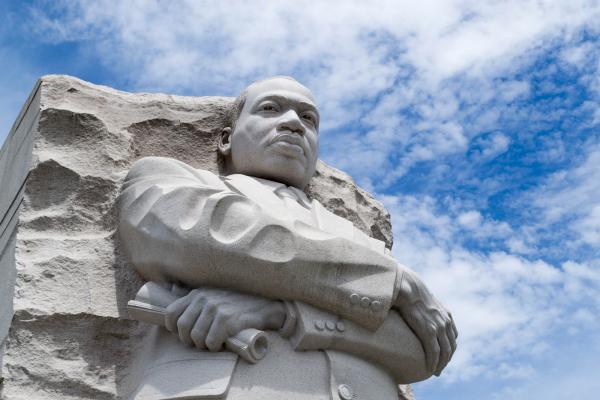On the Friday morning before Martin Luther King Day this year I met nine twentysomething Sojourners interns at the Martin Luther King Jr. Memorial on the National Mall. We collected into a circle, and I told them: “This is sacred ground.”
I explained that we would enter the grounds in silence. I instructed the mostly white group to spend 15 minutes examining the memorial — observe — see what they see. Then we would come back together and share what we saw.
It was early enough that we were the only group on the grounds. We walked through the cut-out stone mountain and it felt like we were pressing into space already in worship, as if the grounds themselves — each flower, each marble panel, the very ground itself — was bowed in reference to God’s work on earth.
What did we see?
King was carved out of a thick chunk of rock cut out from a thick mountain of pain.
Pushed forward from the rock, King stood in the middle of the memorial. From the side it is clear: There is still some distance to go to reach the other side.
From the side, King looks like he is pushing through the rock, but not free of it.
Up close the details of King’s suit declare he was in the middle of his day — not the well-pressed beginning nor the well-worn end. Toward the top the defined detail is striking: King’s eyes pierce. His brow is furrowed. His collar and lapel lay perfectly crisp while King’s rumpled suit sleeves reveal a man in action. His arms fold across his chest with steely determination. Three suit buttons rest at King’s wrist where veins protrude giving witness to the stress of the moment.
The top of the monument is full of detail, but as the gaze dips down, details fade at King’s feet. Feet known for marching are encased in stone. King did not realize his dream. Life cut short by an assassin’s bullet, he did not become all he was created to be. He was never set free from the rock.
Etched into a long marble wall that stands at King’s back are the wise words he still offers to the world — like bread crumbs on the journey to justice.
Feet from the monument we stood in a circle sharing these observations on this frigid day in January.
I asked the young people: “What was it all about? What was that great push we call the civil rights movement all about?”
One said: “Organizing — it’s power. The movement gave us different tactics that work.”
Another said: “It showed white people their racism.”
Another said: “It was about black empowerment.”
I lowered the zipper on my coat, pulled back the collar, and removed a strand of inch-long ceramic beads strung together by ancient rope. I pulled it over my head and presented it to them.
“These are slave beads,” I explained. “This is what the push was all about.”
I continued, “These beads were made in England in the 1700s. They were traded in Africa for human beings. This was what black lives were worth — the cost of these beads.”
A collector gave the beads to my dear friend as a gift. She then gifted them to me.
I passed the beads around: Each intern held them and passed them to the next.
These beads are evidence of the deep-rooted lie of human hierarchy.
From Plato’s pontification in The Republic that different people groups are made of different metals and their metal determines how they will serve the Republic …
To Pope Nicolas V’s 1454 Pontifex Romanus that declared explorers had the right to claim land for the throne and enslave the people they “discovered” if the land was not civilized (aka Christian) …
To the botanist, Linnaeus, whose grand idea that human classification might mirror that of fauna laid foundations for scientific racism …
To the 1787 U.S. Constitutional Convention that concretized the lie, encasing it in law, that enslaved people of African descent would hereby be deemed 3/5 of a human being …
To the Immigration Act of 1790, which declared white men the only ones sanctioned to become naturalized citizens. The significance? Only white men could vote. The spiritual declaration? “Only white men are created and called to exercise dominion on this land.”
This is what the push for abolition was about.
This is what the 13th, 14th, and 15th Amendments were about.
This is what the Dred Scott decision and Plessy v. Ferguson were about.
This is what the Indian removals were about.
This is what women’s suffrage was about.
This is what Jim Crow, and lynching, and peonage were about.
This is what the Montgomery Bus Boycott and the lunch counter sit-ins and Birmingham and Selma and the Civil Rights Act and the Voting Rights Act and the Meredith March Against Fear and the Sanitation Workers’ Strike and the Poor People’s Campaign and the assassination of Dr. King were all about.
And this is what the environmental justice movement, and the Movement for Black Lives, and the push against current-day voter suppression, and the Women’s March is all about.
It is about the lie of human hierarchy.
It is a lie that some must be sacrificed to the hungry gods of capitalism, militarism, misogyny, and racism in order to “maintain our way of life.”
This is what it is all about. This is why we march. This is why we sit-in. This is why we boycott. This is why we pledge to protect Muslims, and immigrants, and black men, women, and children in the name of Jesus Christ.
This is why we must push through the rock!
Because we are called to resist the lie.
I asked the interns to engage in resistance by submitting to the wisdom of the marginalized.
Each intern found their favorite quote from Dr. Martin Luther King Jr. on the wall behind us and they are now committing it to memory.
Faith in Action is a monthly compilation of articles that empower people of faith to draw from a deep well and boldly advocate for a more just world. Subscribers receive monthly resources for prophetic preaching, practical insights for organizing, and reflections on spiritual leadership delivered to their e-mail. Subscribe here.
Got something to say about what you're reading? We value your feedback!

